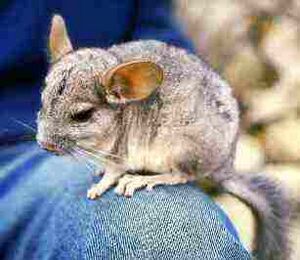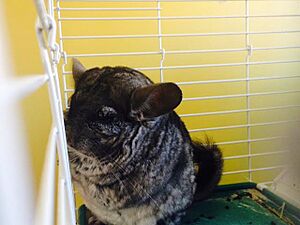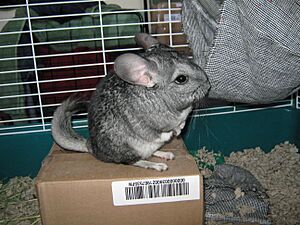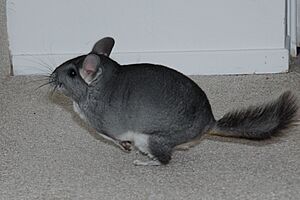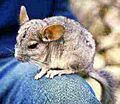Long-tailed chinchilla facts for kids
Quick facts for kids Long-tailed chinchilla |
|
|---|---|
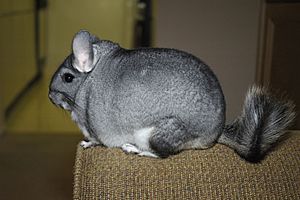 |
|
| Long-tailed chinchilla in a domestic setting | |
| Conservation status | |
| Scientific classification | |
| Genus: |
Chinchilla
|
| Species: |
lanigera
|
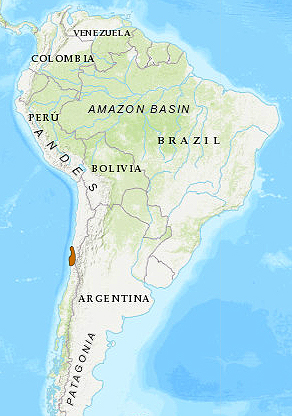 |
|
| Long-tailed chinchilla range in 2016 | |
| Synonyms | |
|
Mus laniger |
|
The long-tailed chinchilla (Chinchilla lanigera) is a type of rodent. It is also known as the Chilean, coastal, common, or lesser chinchilla. There are two main types of chinchillas, and this is one of them. The other is C. chinchilla.
Both types of chinchillas are endangered in the wild. This is because people used to hunt them a lot for their very soft fur. The chinchillas kept as pets today are thought to come from the long-tailed chinchilla species. Pet chinchillas come in three main types: la plata, costina, and raton.
Historically, long-tailed chinchillas lived in Chile and Peru. By the mid-1800s, they were mostly found in central Chile. Today, wild groups of these chinchillas live in specific areas of Chile. These include Aucó, near Illapel, and in the Reserva Nacional Las Chinchillas.
Contents
Physical Features
The long-tailed chinchilla is smaller than its cousin, C. chinchilla. Wild long-tailed chinchillas can be up to 260 millimeters (about 10 inches) long. They have rounder ears, about 45 millimeters (1.8 inches) long. Their tail is also longer, usually about a third of their body size. It can be up to 130 millimeters (5 inches) long.
Male chinchillas usually weigh between 369 and 493 grams (about 0.8 to 1.1 pounds). Females weigh a bit more, from 379 to 450 grams (about 0.8 to 1 pound). Pet chinchillas are often larger than wild ones. Female pets can weigh up to 800 grams (1.8 pounds), and males up to 600 grams (1.3 pounds).
The name lanigera means 'bearing a woolen coat'. However, chinchillas do not have wool. Instead, they have very soft hair. In the wild, their hair was usually a mottled yellow-gray color. Through breeding, pet chinchillas now come in many colors. These include beige, white, and ebony. Their hair is 2 to 4 centimeters (0.8 to 1.6 inches) long. It is very silky and soft. Up to 75 hairs can grow from a single hair follicle.
Chinchillas have long, strong whiskers called vibrissae. These can be 100 to 130 millimeters (4 to 5 inches) long. Their upper body is usually bluish or silvery gray. Their belly is yellowish-white. The tail has long, coarse gray and black hairs. These hairs form a bristly tuft at the end of the tail.
Chinchillas have vertical pupils in their eyes. They also have soft foot pads, called pallipes. They can use their front paws to hold things, much like humans use their hands. Their back legs are longer than their front legs, similar to rabbits.
Types of Pet Chinchillas
There are three main types of domestic chinchillas. These are the la plata, costina, and raton types.
The la plata type has strong muscles and bones. It looks more round or compact. It has a short, wide head and a straight back. Its shoulders are often as wide as its chest and rump. Its ears are short and almost perfectly round.
The costina type has lighter muscles and bones. Its most noticeable feature is its long hind legs. Its front legs are shorter and closer together. Its shoulders are narrower. Its back is more arched, sometimes forming a slight hump. Its head looks V-shaped from the front, with a pointed nose. Its ears are long and stick out at about a 45-degree angle.
The raton type is similar to the la plata type in body shape. However, its nose is pointed, like the costina type. Its ears are very close together and more horizontal. This type is generally smaller than the others.
Where Chinchillas Live
Wild Homes
Wild chinchillas live in burrows or rock cracks. They are found in the Andes Mountains of Northern Chile. They live at very high elevations, from about 3,000 to 5,000 meters (9,800 to 16,400 feet).
The weather in their natural home is quite harsh. Summer daytime temperatures can reach 30°C (86°F) in the shade. At night, temperatures can drop to 7°C (45°F). In winter, it can even go below freezing. In the wild, they usually have babies between October and December. These are the spring months in the Southern Hemisphere.
Pet Homes
Pet chinchillas need a cool and dry place to live. The best temperature for them is between 18.3°C and 26.7°C (65°F and 80°F). Very high temperatures (above 26.7°C or 80°F) are bad for them. They can even get heatstroke. Very low temperatures (below 0°C or 30°F) are also not good. High humidity can also affect their fur growth.
Chinchilla Behavior
Chinchillas are crepuscular animals. This means they are most active during twilight hours, like dawn and dusk. They are herbivores, meaning they eat plants. They like to live in groups and are very social. Males and females usually get along well, even during breeding season. Female chinchillas are often the leaders of the group.
Chinchillas need a lot of dietary fiber in their food. A good diet for them includes high-quality grass hay, chinchilla pellets, and small amounts of vegetables and fruits. They should always have clean, filtered water in a bottle with a sipper tube. Adult chinchillas eat about 5-6% of their body weight each day. When they eat, they sit on their back legs like a squirrel. They use their front paws to hold their food and bring it to their mouth.
Chinchillas also need a dust bath at least twice a week. They roll around in fine volcanic ash. This helps keep their fur clean and healthy.
Reproduction and Life Cycle
Chinchillas usually breed from November to May in the Northern Hemisphere. In the Southern Hemisphere, it's from May to November. Female chinchillas are pregnant for 110 to 124 days. They can have babies up to two times a year. Each time, they can have 1 to 6 babies.
Newborn chinchillas are born with fur. They can run around right after they are born. They weigh about 35 grams (1.2 ounces) at birth. They drink their mother's milk for about 45 days (6 to 8 weeks). Chinchillas become adults when they are about 8 months old. On average, they live for about 10 years. Some can even live up to 20 years if cared for well by humans.
Conservation Status
The long-tailed chinchilla is an endangered species. It is one of the most important mammals in Chile to protect. This is mainly because they were hunted so much for their fur in the past.
Images for kids
See also
 In Spanish: Chinchilla de cola larga para niños
In Spanish: Chinchilla de cola larga para niños



